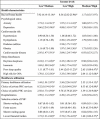Association of Family Income with Health Indices and Healthcare Utilization in a Large Sample of Residents in Northern Greece
- PMID: 33603907
- PMCID: PMC7879352
- DOI: 10.26574/maedica.2020.15.4.490
Association of Family Income with Health Indices and Healthcare Utilization in a Large Sample of Residents in Northern Greece
Abstract
Objective:To describe the impact of subjects' family income, which was used as a proxy for socioeconomic status, with health characteristics and healthcare utilization of a large representative sample of population in Northern Greece, taking into account several socio-demographic characteristics and health behaviors of the participants. Material and method:Eight hundred and twelve participants (43.7% males) with a mean age of 49.±14.8 years (range 19-83 years), from the area of Thrace, Greece, were enrolled in this cross-sectional populational study. A two-stage stratified sampling scheme was used and subjects were classified, according to the net mean monthly household income, into three financial levels: low .1000 Euro; medium 1001-2000 Euro; and high >2000 Euro. Self-reported questionnaires for socio-demographic, lifestyle and health related characteristics were collected. Sleep characteristics, utilizing Epworth Sleepiness Scale, Athens Insomnia Scale, Pittsburgh Sleep Quality Index and Berlin Questionnaire, and mental health, using Zung Self-rating Anxiety Scale and Beck Depression Inventory have been also assessed. Results:The majority of participants belonged to the lower income level (476 subjects, 58.6%). Lower income level was associated with a higher prevalence of high alcohol consumption (p=0.030), low adherence to Mediterranean diet (p=0.016), low physical activity (p<0.001) and either short or long nocturnal sleep duration (p<0.001). After adjusting for all socio-demographic and lifestyle characteristics, subjects with low income had a higher risk for anxiety (aOR=1.97, p=0.017), depression (aOR=4.88, p<0.001), dyslipidemia (aOR=2.50, p=0.007), diabetes (aOR=3.58, p<0.001), obesity (aOR=1.97, p=0.038), cardiovascular disease (aOR=3.04, p=0.015) and sleep disorders, as well as for primary (aOR=3.56, p=0.017) and secondary (aOR=2.49, p=0.010) healthcare utilization compared to subjects with high income. Conclusion:Low income is an important factor, which adversely affects the health of individuals via different pathways such as adaptation of harmful everyday habits. Large-scale prospective cohort studies are necessary to verify these associations in a methodologically more robust way.
Figures




Similar articles
-
Insight into the relationship between sleep characteristics and anxiety: A cross-sectional study in indigenous and minority populations in northeastern Greece.Psychiatry Res. 2020 Oct;292:113361. doi: 10.1016/j.psychres.2020.113361. Epub 2020 Aug 4. Psychiatry Res. 2020. PMID: 32771838
-
Association between sleep insufficiency and dyslipidemia: a cross-sectional study among Greek adults in the primary care setting.Sleep Sci. 2022 Jan-Mar;15(Spec 1):49-58. doi: 10.5935/1984-0063.20200124. Sleep Sci. 2022. PMID: 35273747 Free PMC article.
-
Exploring the association between sleep insufficiency and self-reported cardiovascular disease among northeastern Greeks.Sleep Sci. 2022 Oct-Dec;15(4):388-398. doi: 10.5935/1984-0063.20220069. Sleep Sci. 2022. PMID: 36419814 Free PMC article.
-
The association between sleep pathology and depression: A cross-sectional study among adults in Greece.Psychiatry Res. 2020 Dec;294:113502. doi: 10.1016/j.psychres.2020.113502. Epub 2020 Oct 8. Psychiatry Res. 2020. PMID: 33068911
-
Sleep insufficiency and incident diabetes mellitus among indigenous and minority populations in Greece.Sleep Sci. 2021 Apr-Jun;14(Spec 2):101-110. doi: 10.5935/1984-0063.20200081. Sleep Sci. 2021. PMID: 35082978 Free PMC article.
Cited by
-
"How Do Greeks Sleep?" A Cross-Sectional Study among Indigenous and Minority Populations.Maedica (Bucur). 2022 Sep;17(3):615-627. doi: 10.26574/maedica.2022.17.3.615. Maedica (Bucur). 2022. PMID: 36540581 Free PMC article.
-
Examining the Impact of Food Security and Accessibility to Healthcare Services on Chronic Disease Risk Among Rohingya Refugees in Bangladesh.Healthcare (Basel). 2025 Feb 14;13(4):417. doi: 10.3390/healthcare13040417. Healthcare (Basel). 2025. PMID: 39997292 Free PMC article.
-
Healthcare utilization and its association with socioeconomic status in China: Evidence from the 2011-2018 China Health and Retirement Longitudinal Study.PLoS One. 2024 Mar 14;19(3):e0297025. doi: 10.1371/journal.pone.0297025. eCollection 2024. PLoS One. 2024. PMID: 38483924 Free PMC article.
-
Evaluating the Influences of Health Expenditure, Energy Consumption, and Environmental Pollution on Life Expectancy in Asia.Int J Environ Res Public Health. 2023 Feb 23;20(5):4000. doi: 10.3390/ijerph20054000. Int J Environ Res Public Health. 2023. PMID: 36901013 Free PMC article.
-
Use of Edible, Medicinal, and Aromatic Plants in Various Health Disorders: A Cross-Sectional Evaluation among Inhabitants in the Area of Thrace, North-Eastern Greece.Int J Environ Res Public Health. 2022 Oct 1;19(19):12576. doi: 10.3390/ijerph191912576. Int J Environ Res Public Health. 2022. PMID: 36231876 Free PMC article.
References
-
- Organization for Economic Co-operation and Development (OECD) Society at a Glance 2014. Available from https://read.oecd-ilibrary.org/social-issues-migration-health/society-at.... Accessed on November 3rd, 2020. 2020.
-
- Andriopoulou E, Karakitsios A, Tsakloglou P. Inequality and Poverty in Greece: Changes in Times of Crisis. In: Katsikas D, Sotiropoulos D, Zafiropoulou M, eds. Socioeconomic Fragmentation and Exclusion in Greece under the Crisis. New Perspectives on South-East Europe. Palgrave Macmillan/Cham. 2018. pp. 23–54.
-
- Organization for Economic Co-operation and Development (OECD) Youth unemployment rate. 2018 figures. Available from: https://data.oecd.org/unemp/youthunemployment- rate.htm#indicator-chart. 2020.
-
- Mitrakos T. Inequality, poverty and living conditions in Greece: Recent developments and prospects. Social Cohesion and Development. 2013;1:37–58.
-
- Eurostat. In-work poverty in the EU. 2017 figures. Available from: https://ec.europa.eu/eurostat/web/ products-eurostat-news/-/DDN-20180316-1. Accessed on November 3rd, 2020. 2020.
Publication types
LinkOut - more resources
Full Text Sources
